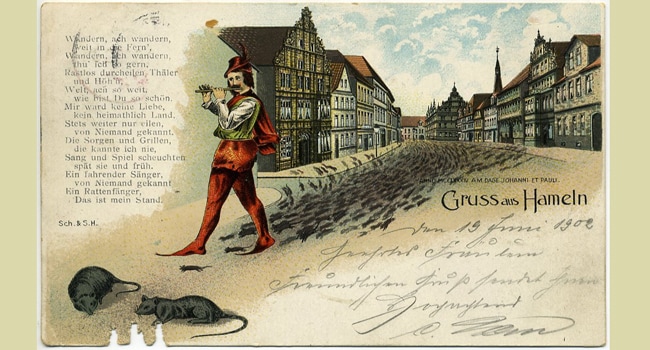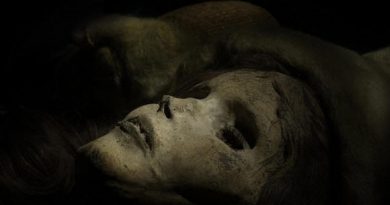Mass abduction of 130 children – True Story of Pied Piper of Hamelin
On the evening of June 26th, 1284, a large number of children in the town of Hamelin, Saxony, Germany, disappeared. Although this is often seen as a fairy tale, it was in fact a real historical event. While it has been embellished, had multiple elements added, and cleaned up so as not to frighten children, the story of the Pied Piper of Hamelin is not a myth.
There are enough independent records contemporary to the time, to establish that something did occur in 1284. The town record records, in 1384, “It has been 100 years since our children left”. There are also multiple accounts of a stained glass window in the church (I’m unsure if this is St. Boniface Minster, or the Marktkirche) appearing around 1300. The church is said to have undergone extensive renovations after a fire in 1660, with the glasswork disappearing, but it is recorded in many accounts and a reconstruction exists today. There’s also an inscription on the “Pied Piper House”, among other sources.
The Luneburg manuscript, dated to 1440, doesn’t mention rats, however they are present in the 1553 chronicle by Hans Zeitlos and most later accounts, including Browning and Grimm.
Most of us must have heard of the Pied Piper of Hamelin, the pipe playing rat-catcher from the popular fairy tale who took away the town’s children as an act of revenge when not paid his dues. Ever wondered whether there is some history behind it?
Origin of the tale
The Pied Piper of Hamelin, originally called ‘The Children of Hameln’, is a tale from the book Children’s and Household Tales (German: Kinder- und Hausmrchen) written in 1812 by the Grimm brothers, Jacob and Wilhelm. The collection of German fairy tales is commonly known in English as Grimm’s Fairy Tales.
The tales were not originally meant for children. They were the documentation of centuries-old Germanic folklores that had till then been spread orally. The fascinating tales revealed much about the old Germanic culture and traditions. As such, they were not the kind of happily-ever-after stories you might expect, but at times, pretty dark.
As many stories carried magical elements and carried morals, they became popular among children and were toned down to suit the young audience. Bits and pieces of bizarre historical events peek out from the original fairy tales and the one on the Pied Piper is no different. The tale shows the importance of good governance and cautions us against dishonest dealings.
How does the story go?
The Pied Piper of Hamelin plays out in the Germanic town of Hamelin (now called Hameln) in 1284. The town had been suffering from a severe rat infestation when a man arrived carrying a musical pipe and wearing ‘pied’ or multicoloured clothing. He promised the mayor to rid the town of its rats in exchange for a fee.
The music he played on his pipe attracted all the town’s rats towards him, after which, he led the entranced animals to the Weser River nearby, where they all dove in and drowned.
However, the mayor refused to pay the piper and he went away planning revenge. On June 26, the day of St John and also of St Paul, the piper returned, dressed as a hunter and wearing a red hat. He was playing a different tune.
This time, all the town’s children followed him hypnotised. The piper led them to a mountain cave, and the children were never heard from again. The story notes that the mayor’s grown up daughter was among the children who were lost.
1. The inscription on the church window:
The Grimm story notes that to commemorate the horrific incident, the townspeople put the following inscription on the town hall:
In the year 1284 after the birth of Christ
From Hameln were led away
One hundred thirty children, born at this place
Led away by a piper into a mountain.

Painting copied from the original stained glass window
The story also notes that “In the year 1572 the mayor had the story portrayed in the church windows. The accompanying inscription has become largely illegible. In addition, a coin was minted in memory of the event.”
The inscription put up by the people on a stained glass church window in the town read, “On the day of John and Paul 130 children in Hamelin went to Calvary and were brought through all kinds of danger to the Koppen mountain and lost.”
Though the stained glass window depicted a group of children along with a motley-clad fellow, the inscription says nothing about a piper. The window seems to have been destroyed by now, though accounts of it still remain.
2. The inscription on the gate:
Moreover, according to the story, a gate was built in the town “272 years after the magician led the 130 children from the city”, on which was inscribed: “Centum ter denos cum magus ab urbe puellos duxerat ante annos CCLXXII condita porta fuit.”
3. The inscription on the house:
A footnote included in later editions of the original Grimm’s fairy tales said:
Inscription, in gold letters, on a house in Hameln: “In the year 1284 on the Day of John and Paul, the 26th of June, a piper wearing clothes of many colors abducted 130 children, born in Hameln and lost at Calvary on the Koppen.”

Inscription in the Pied Piper House
The house this footnote speaks of is now known as the Pied Piper House. It is called so because of the inscription on the side and not because the piper lived here. This inscription is similar to the one put on the church window but this one does mention the existence of the piper. The stone facade of the house dates to around 1602, but the house itself is said to be older.

Wood engraving of the Pied Piper House
4. The Lneburg Manuscript (c. 1440-50):
Heinrich of Herferd, a monk, wrote about this incident in the Lneburg Manuscript more than a century after the window had been constructed. He speaks about a man of around 30 who came to the town playing a flute and led away its children.
Other accounts of the horrific incident
Scholars and researchers believe that something tragic must have happened in the town of Hamelin for this story to have emerged:
- A common theory is that the children of the town suffered from some sort of epidemic. It has been suggested by historians that the mass grave for the children has been denoted as their site of disappearance
- Since rat infestations were a common story back in the 13th century, the children could have been inflicted with the bubonic plaque or even an early strain of the Black Death. The ‘pied’ clothing of the piper could be an indication of the splotchy skin lesions accompanying the disease. The most supported theory, post historical and epidemiologic arguments, was presented in favour of murine typhus as the predominant Hamelin epidemic

The Pied Piper House at present
- Yet another theory says that the dancing children were exhibiting symptoms of Huntington’s disease, which impairs walking, gait and causes involuntary jerking movements
- So, why weren’t adults infected? This could be explained by the theory that says the incident took place a few decades earlier and the children actually went on an ill fated children’s crusade. Europeans would participate in crusades at the time, following one child with “a vision from God” to go to the said ‘holy land’ and win it for Christendom
- In a colonisation theory, it is said that the children went into the cave and came out on the other side in Transylvania, i.e. they went east to form a colony of their own. Jack David Zipes, a fairy tale scholar, supports this theory with documents showing that someone had come to Hamelin at that time to take in new recruits to colonise parts of Eastern Europe
- William Manchester, in his book, A World Lit Only by Fire, theorised that the piper was a paedophile and murderer who snatched up the children, killed and scattered their mutilated bodies.
Source :
https://www.ancient-origins.net/myths-legends/disturbing-true-story-pied-piper-hamelin-001969



